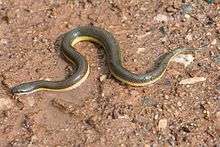Rice paddy snake
The rice paddy snake or plumbeous water snake (Hypsiscopus plumbea) is a species of mildly venomous, rear-fanged snake endemic to South Asia.
| Rice paddy snake | |
|---|---|
 | |
| Hypsiscopus plumbea from Phetchabun Province, West Thailand | |
| Scientific classification | |
| Kingdom: | Animalia |
| Phylum: | Chordata |
| Class: | Reptilia |
| Order: | Squamata |
| Suborder: | Serpentes |
| Family: | Homalopsidae |
| Genus: | Hypsiscopus |
| Species: | H. plumbea |
| Binomial name | |
| Hypsiscopus plumbea (F. Boie, 1827) | |
| Synonyms[2] | |
| |
Geographic range
H. plumbea is found in India, Burma, Cambodia, Indonesia, Laos, Malaysia, southeastern China, Thailand, and Vietnam.
Habitat
The rice paddy snake is a common and abundant species associated with all sorts of wet habitats.
Taxonomy
DNA evidence suggests that this taxon might be a species complex.[1]
Description
The rice paddy snake is a relatively small snake, reaching a total length (including tail) of up to 72 cm (28 in).[3]This snake feed readily on small fish, frogs, and occasionally small lizards. It has countershading coloration, which is dark brown to grey in upper part of its body, and light colored white to yellowish color at the bottom of its body. This snake mostly nocturnal, and give birth to live young (ovoviviparous)

 Enhydris plumbea
Enhydris plumbea
from Karawang, West Java
References
- Murphy, J. (2010). "Enhydris plumbea". IUCN Red List of Threatened Species. 2010: e.T176699A7285894. doi:10.2305/IUCN.UK.2010-4.RLTS.T176699A7285894.en.
- "Hypsiscopus plumbea ". The Reptile Database. www.reptile-database.org.
- Breuer, Hans; William Christopher Murphy (2009–2010). "Enhydris plumbea". Snakes of Taiwan. Retrieved 13 October 2012. External link in
|work=(help)
Further reading
- Boie, F. (1827). "Bemerkungen über Merrem's Versuch eines Systems der Amphibien, 1. Lieferung: Ophidier ". Isis van Oken [Jena] 20: 508–566. (Homalopsis plumbea, new species, p. 550).
- Boulenger, G.A. (1896). Catalogue of the Snakes in the British Museum (Natural History). Volume III., Containing the Colubridæ (Opisthoglyphæ and Proteroglyphæ), ... London: Trustees of the British Museum (Natural History). (Taylor and Francis, printers). xiv + 727 pp. + Plates I-XXV. (Hypsirhina plumbea, pp. 5–6).
- Das, Indraneil. (2006). A Photographic Guide to Snakes and Other Reptiles of Borneo. Sanibel Island, Florida: Ralph Curtis Books. 144 pp. ISBN 0-88359-061-1. (Enhydris plumbea, p. 34).
- Ghodke, Sameer; Harry V. Andrews. (2002). Enhydris plumbea (Boie, 1827) (Serpentes: Colubridae: Homalopsinae), a new record for India. Hamadryad 26 (2): 373–375. [2001]
- Gray, J.E. (1842). Monographic Synopsis of the Water Snakes, or the Family Hydridae. Zoological Miscellany 1842: 59–68. (Hypsirhina plumbea, p. 66).
- Smith, M.A. (1943). The Fauna of British India, Ceylon and Burma, Including the Whole of the Indo-Chinese Sub-region. Reptilia and Amphibia. Vol. III.—Serpentes. London: Secretary of State for India. (Taylor and Francis, printers). xii + 583 pp. (Enhydris plumbea, pp. 382–383, Figure 122).
- Stejneger, Leonard. (1907). Herpetology of Japan and Adjacent Territory. United States National Museum Bulletin 58. Washington, District of Columbia: Smithsonian Institution. xx + 577 pp. (Enhydris plumbea, pp. 300–302, Figures 260-262).
- Voris, Harold K.; Karns, Daryl R. (1996). Habitat utilization, movements, and activity patterns of Enhydris plumbea (Serpentes: Homalopsinae) in a rice paddy wetland in Borneo. Herpetological Natural History 4 (2): 111–126.
